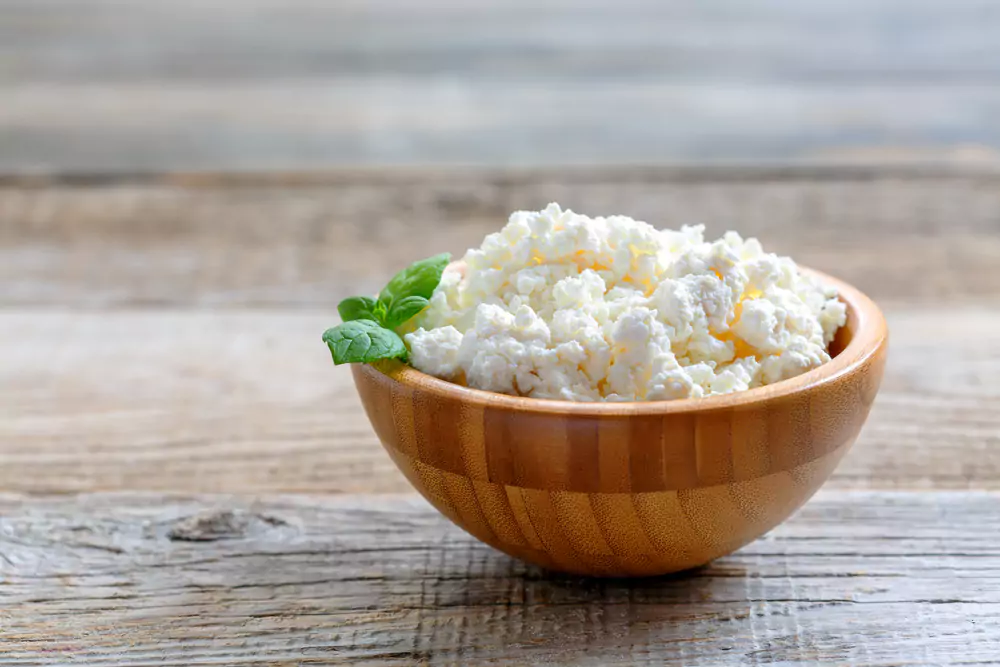Cottage cheese is a popular dairy product that people worldwide have enjoyed for centuries. It is known for its unique texture and taste, which sets it apart from other types of cheese. If you have never tried cottage cheese before, you may be wondering what does cottage cheese tastes like and whether or not it is something you would enjoy.
No matter what you are concerned about, this article covers everything you need to know about this cheese.
What Is Cottage Cheese?

Cottage cheese is a type of cheese that is known for its creamy and lumpy texture. It is made by curdling milk with the help of an acidic substance, such as lemon juice or vinegar. The curds are then separated from the whey, resulting in a soft, mild-flavored cheese. Cottage cheese is typically low in fat and calories, making it a popular choice among health-conscious individuals. It can be enjoyed independently or used as an ingredient in various dishes, such as salads, dips, and desserts.
Cottage Cheese Varieties
There are several varieties of cottage cheese available, each with its unique characteristics. Here are some of the most common cottage cheese varieties.
Regular Cottage Cheese
Regular cottage cheese is the most common variety found in grocery stores. It typically has a creamy texture with small curds and a slightly tangy flavor. The curds are soft and moist, giving the cottage cheese a smooth consistency. Regular cottage cheese is often labeled with different fat percentages, such as low-fat, reduced-fat, or full-fat, depending on the amount of milk fat present in the product. It can be enjoyed on its own, mixed with fruits or vegetables, or used as an ingredient in various dishes.
Low-Fat Cottage Cheese
Low-fat cottage cheese is a variation of regular cottage cheese that contains less milk fat. It is made using skim milk or by removing some of the cream from whole milk before curdling. This variety is popular among individuals who are watching their calorie intake or following a low-fat diet. Low-fat cottage cheese has a similar texture to regular cottage cheese but may have a slightly less creamy mouthfeel due to the reduced fat content. It can be used in the same way as traditional cottage cheese and is often preferred by those looking for a lighter option.
Non-Fat Cottage Cheese
Non-fat cottage cheese, also known as fat-free cottage cheese, is another variation that contains no milk fat at all. It is made using skim milk and has the lowest calorie content among all cottage cheese varieties. Non-fat cottage cheese has a slightly different texture compared to regular and low-fat varieties, as the absence of fat affects the creaminess. However, it still maintains the characteristic curds and tangy flavor. This variety is commonly used by individuals on strict low-fat or calorie-restricted diets.
Small-Curd Cottage Cheese
Small-curd cottage cheese refers to a variety where the curds are smaller in size compared to regular cottage cheese. The curds are typically less than 1/4 inch in diameter, giving the cottage cheese a smoother texture. Small-curd cottage cheese is often preferred by those who enjoy a more uniform consistency and find larger curds less appealing. It can be used in the same way as regular cottage cheese and is suitable for both savory and sweet dishes.
Large-Curd Cottage Cheese
Large-curd cottage cheese is the opposite of small-curd cottage cheese, with curds that are larger in size. The curds in this variety can range from 1/4 inch to 1/2 inch in diameter, resulting in a chunkier texture. Large-curd cottage cheese has a more substantial mouthfeel and may be preferred by those who enjoy a more textured experience. It can be used in various recipes, such as salads or casseroles, where the larger curds add a distinct texture.
How Is Cottage Cheese Made?
Cottage cheese is made through a simple process that involves the coagulation of milk and the separation of curds from the whey. The first step in making cottage cheese is to heat milk, typically cow’s milk, to a specific temperature, usually around 100°F (38°C). Heating the milk helps to kill any harmful bacteria and also activates enzymes present in the milk. Once the desired temperature is reached, an acidifying agent such as lemon juice or vinegar is added to the milk. This acidification causes the milk to curdle, forming solid curds and liquid whey.
The next step is to separate the curds from the whey. This can be done by gently stirring the mixture, which encourages the curds to clump together. After going for a few minutes, the mixture is left undisturbed for about 30 minutes to allow further separation. During this time, the curds continue to form and become more solid while the whey settles at the bottom.
Once the curds have sufficiently formed, they are carefully ladled into a cheesecloth-lined colander or strainer. The cheesecloth helps to drain off excess whey while retaining the curds. The curds are then rinsed with cold water to remove any residual whey and cool them down.
At this point, the cottage cheese can be enjoyed as is or further processed depending on personal preference. Some manufacturers may add cream or other dairy products to enhance the flavor and texture of cottage cheese. Additionally, salt may be added for taste.
What Does Cottage Cheese Taste Like?
Cottage cheese is a fresh cheese with a mild and slightly tangy flavor. It is known for its creamy and curdy texture, achieved through curdling milk with an acid or rennet. The taste of cottage cheese can vary depending on the brand and the specific production methods used. Generally, it has a subtle dairy flavor with a hint of acidity. Some people describe it as slightly salty or sour, while others find it more neutral. The texture of cottage cheese is often compared to that of ricotta or yogurt, with small curds that are soft and moist. It is commonly used in sweet and savory dishes and enjoyed as a healthy snack.
What Do You Eat Cottage Cheese With?
People are concerned about what does cottage cheese goes with. Here are different ways cottage cheese can be consumed and paired with other foods.
As a Standalone Snack
Cottage cheese can be enjoyed as a simple and healthy snack on its own. Many people prefer to eat it straight from the container, either plain or with a sprinkle of salt and pepper. This allows you to savor cottage cheese’s natural taste and texture without any additional ingredients.
With Fruits
Cottage cheese pairs exceptionally well with various fruits, making it a refreshing and nutritious option for breakfast or a light meal. You can top cottage cheese with fresh berries such as strawberries, blueberries, raspberries, sliced peaches, pineapple, or mangoes. The combination of creamy cottage cheese and juicy fruits creates a delightful contrast of flavors and textures.
In Salads
Cottage cheese can be incorporated into salads to add creaminess and protein. It works particularly well in green, pasta, or grain-based salads. For example, you can mix cottage cheese with lettuce, cucumber, cherry tomatoes, and your choice of dressing for a quick and easy salad. Additionally, cottage cheese can be used as a substitute for mayonnaise or sour cream in traditional salad recipes to reduce the calorie content while maintaining a creamy texture.
With Vegetables
Cottage cheese can be paired with various vegetables to create tasty and nutritious dishes. For instance, you can stuff bell peppers or tomatoes with cottage cheese filling and bake them until tender. Another option is to mix cottage cheese with steamed or roasted vegetables like broccoli, cauliflower, or carrots for a healthy side dish. The versatility of cottage cheese allows you to experiment with different vegetable combinations based on your preferences.
In Baked Goods
Cottage cheese can be used as an ingredient in baked goods to enhance their texture and nutritional value. It can be added to muffins, pancakes, or bread recipes to make them moist and fluffy. Cottage cheese can also be used as a filling for pastries or a topping for cheesecakes, adding a creamy and tangy element to the final product.
How To Tell If Cottage Cheese Is Bad?
Here are various indicators that can help you determine if your cottage cheese has gone bad.
Expiration Date
The first step in determining the freshness of cottage cheese is to check the expiration date on the packaging. Manufacturers typically provide a “best by” or “use by” date, which indicates the period during which the product is expected to retain its quality and flavor. If the cottage cheese is past its expiration date, it is advisable to discard it, as it may have already started to spoil.
Visual Inspection
Visual cues can often reveal signs of spoilage in cottage cheese. Here are some visual indicators to look out for:
- Check for any visible mold on the surface of the cottage cheese. Mold can appear as fuzzy green, blue, or white patches. If you notice mold growth, it is best to discard the entire container, as mold can produce harmful toxins that may cause illness.
- Fresh cottage cheese should have a creamy white color. If you observe any yellowing or browning of the cheese, it may indicate spoilage.
- Cottage cheese should have a moist but not excessively watery texture. If you notice excessive liquid separation or a runny consistency, it could be a sign that the cottage cheese has gone bad.
Smell Test
Another way to determine if cottage cheese has spoiled is by using your sense of smell. Fresh cottage cheese typically has a mild, slightly tangy aroma. However, if you detect any off-putting odors, such as a sour, ammonia-like smell, it is likely that the cottage cheese has spoiled and should be discarded.
Texture and Consistency
In addition to visual cues and smell, the texture and consistency of cottage cheese can provide valuable information about its freshness. Here are some indicators to consider:
- Clumping: Fresh cottage cheese should have a smooth, uniform texture. If you notice large clumps or chunks in the cheese, it may be a sign of spoilage.
- Sliminess: Spoiled cottage cheese can develop a slimy or sticky texture. If the cheese feels slimy to the touch, it is best to discard it.
- Graininess: Cottage cheese that has gone bad may also exhibit a grainy or gritty texture. This can be an indication of bacterial growth or improper storage conditions.
Cottage Cheese Storage Tips
Here are some helpful tips on how to store cottage cheese to maintain its taste and texture. Know that these are also the best ways you need to know if you are concerned about how to make cottage cheese taste good.
Check the Expiration Date
When purchasing cottage cheese, always check the expiration date on the packaging. This date indicates the last day the product is guaranteed to be at its best quality. It is essential to refrain from consuming cottage cheese past its expiration date as it may spoil and pose a health risk.
Store at the Right Temperature
Cottage cheese should be stored in the refrigerator at a temperature between 35°F (1.7°C) and 40°F (4.4°C). The cold temperature helps slow down bacterial growth and keeps the cottage cheese fresh for longer. Make sure to place the cottage cheese in the most challenging part of your refrigerator, such as the back of a shelf or a designated dairy compartment.
Keep it Sealed
To prevent contamination and maintain freshness, always keep cottage cheese tightly sealed when not in use. If the original packaging is resealable, close it properly after each use. If not, transfer the cottage cheese into an airtight container or cover it tightly with plastic wrap or aluminum foil.
Avoid Cross-Contamination
Cottage cheese has a high moisture content, making it susceptible to absorbing odors from other foods in the refrigerator. To avoid cross-contamination and preserve its original taste, store cottage cheese away from strong-smelling foods like onions, garlic, or fish. It is also advisable to keep it separate from raw meat, poultry, and seafood to prevent any potential bacterial contamination.
Do Not Freeze
Cottage cheese does not freeze well due to its high water content. Freezing can cause the texture to become grainy and watery, resulting in a less desirable eating experience. Therefore, it is best to consume cottage cheese before its expiration date rather than attempting to freeze it for later use.
Use Clean Utensils
When serving cottage cheese, always use clean utensils to avoid introducing bacteria into the container. Dirty utensils can contaminate cottage cheese and accelerate spoilage. Additionally, make sure your hands are clean before handling the product.
Discard Moldy or Off-Smelling Cottage Cheese
If you notice any signs of mold growth or an off-putting smell coming from your cottage cheese, it is best to discard it immediately. Mold can produce harmful toxins that may cause food poisoning or other health issues. Trust your senses and prioritize safety when it comes to consuming dairy products.
Frequently Asked Questions (FAQ’s)
What Does Cottage Cheese Taste Similar To?
Cottage cheese has a unique taste that is difficult to compare directly to other food, but it can be described as tangy, creamy, and slightly salty. Its texture is similar to ricotta or Greek yogurt.
Does Cottage Cheese Taste Like Yogurt?
Cottage cheese does not taste like yogurt, as they have distinct flavors and textures. Cottage cheese has a mild, slightly tangy taste with a creamy and curd-like texture, while yogurt has a tangy and slightly sour taste with a smooth and creamy texture.
Is Cottage Cheese An Acquired Taste?
Cottage cheese can be considered an acquired taste for some individuals due to its unique texture and tangy flavor, which may take time for people to appreciate and enjoy.
What Is The Most Popular Way To Eat Cottage Cheese?
The most popular way to eat cottage cheese is typically as a standalone snack or mixed with fruits, vegetables, or other ingredients in various recipes.
How Healthy Is Cottage Cheese?
It is low in calories, high in protein, and contains essential nutrients like calcium and phosphorus. However, the healthiness of cottage cheese can vary depending on the brand and added ingredients.
What Does Cottage Cheese Taste Like on Reddit?
Cottage cheese has a mild and slightly tangy flavor with a creamy and curdy texture. It is often described as being similar to yogurt or sour cream.
Conclusion
In conclusion, cottage cheese has a unique taste that can be described as tangy, creamy, and slightly salty. Its texture is smooth and lumpy, providing a pleasant contrast. The flavor of cottage cheese can vary depending on the brand and the type of milk used in its production. Some people may find the taste of cottage cheese to be mild and refreshing, while others may find it to be more pungent and sour. Overall, cottage cheese is a versatile ingredient that can be enjoyed on its own or used in various recipes to add a creamy and tangy element.






